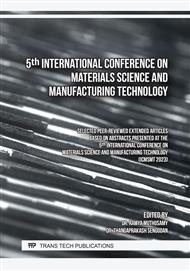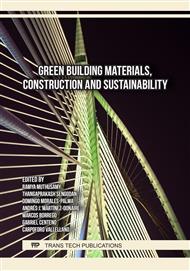[1]
S.B. Yilbaas, Z.A. Sahin, N. Kahraman, Z. Ahmed. Al -Garni, Friction welding of St-A1 and A1-Cu materials, Journal of Materials Processing Technology 49 (1995) 431-443.
DOI: 10.1016/0924-0136(94)01349-6
Google Scholar
[2]
N. Ozdemir, Investigation of the mechanical properties of friction-welded joints between AISI 304L and AISI 4340 steel as a function rotational speed, Materials Letters 59 (2005) 2504 – 2509.
DOI: 10.1016/j.matlet.2005.03.034
Google Scholar
[3]
G. Singh, R.K. Saxena, S. Pandey, An examination of mechanical properties of dissimilar AISI 304 stainless steel and copper weldment obtained using GTAW, Materials Today: Proceedings 26 (2020) 2783-2789
DOI: 10.1016/j.matpr.2020.02.579
Google Scholar
[4]
T.N. Prasanthi, C. Sudha, Ravikirana, S. Saroja, N. Naveen Kumar, G.D. JanakiRam, Friction welding of mild steel and titanium: optimization of process parameters and evolution of interface microstructure, Materials and Design 88 (2015) 58-68.
DOI: 10.1016/j.matdes.2015.08.141
Google Scholar
[5]
A.P. Ramesh, M. Subramaniyan, P. Eswaran, Review On Friction Welding of Similar/ Dissimilar Metals, International Conference on Physics and Photonics Processes in Nano Sciences 1362 (2019) 012032.
DOI: 10.1088/1742-6596/1362/1/012032
Google Scholar
[6]
W. Li, A.Vairis, M. Preuss, T. Ma, Linear and rotary friction welding review, International Materials Reviews 8 (2016) 1743-2804.
DOI: 10.1080/09506608.2015.1109214
Google Scholar
[7]
G. Ananda Rao, N. Ramanaiah, Dissimilar metals AISI 304 steel and AA 2219 aluminum alloy joining by friction welding method, https://doi.org/10.1016/j.matpr.2019.09.028 2214-7853.
DOI: 10.1016/j.matpr.2019.09.028
Google Scholar
[8]
C. Shanjeevi, S. Satishkumar, P. Sathiya, Evaluation of mechanical and metallurgical properties of dissimilar materials by friction welding, Procedia Engineering 64 (2013) 1514 – 1523.
DOI: 10.1016/j.proeng.2013.09.233
Google Scholar
[9]
P. Li, H. Dong, Y. Xia, X. Hao, S. Wang, L. Pan, J. Zhou, Inhomogeneous interface structure and mechanical properties of rotary friction welded TC4 titanium alloy/316L stainless steel joints, Journal of Manufacturing Processes 32 (2018) 54-63.
DOI: 10.1016/j.jmapro.2018.05.001
Google Scholar
[10]
R.Kumar, J.M. Babu, V.K. Bupesh Raja, K. Palanikumar, Ghantasala Pranav Bhargav, Mathew Alphonse, Investigation on mechanical properties of Ti-6al-4 V & SS-304L frictional welding process, Materials Today: Proceedings 46 (2021) 3561-3565.
DOI: 10.1016/j.matpr.2021.01.053
Google Scholar
[11]
M. Kimura, Y.Saitoh, M.Kusaka, K.Kaizu, A. Fuji, Effect of friction welding condition and weld faying surface properties on tensile strength of friction welded joint between pure titanium and pure copper, Journal of Solid Mechanics and Materials Engineering 21 (2011) 11-0334.
DOI: 10.1299/jmmp.5.849
Google Scholar
[12]
M.K. Lee, J.G. Lee, J.K. Lee, J.J. Park, G.J. Lee, Y.R. Uhm, C.K. Rhee, Strong bonding of titanium to copper through the elimination of the brittle interfacial intermetallics, Nuclear Materials Research Center, Korea Atomic Energy Research Institute, Yuseong, Daejeon 13 (2008) 305-353.
DOI: 10.1557/jmr.2008.0269
Google Scholar
[13]
S.D. Meshram, T. Mohandas, G. Madhusudhan Reddy, Friction welding of dissimilar pure metals, Journal of Materials Processing Technology 184 (2007) 330–337.
DOI: 10.1016/j.jmatprotec.2006.11.123
Google Scholar
[14]
C.H. Muralimohan, S. Haribabu, Y. Hariprasadreddy, V. Muthupandi, K. Sivaprasad, Evaluation of microstructures and mechanical properties of dissimilar materials by friction welding, Procedia Materials Science 5 (2014) 1107 – 1113.
DOI: 10.1016/j.mspro.2014.07.404
Google Scholar
[15]
O. Taguchi & Y.Iijima, Diffusion of copper, silver and gold in α-titanium, Philosophical Magazine A, 72:6 (1995) 1649-1655
DOI: 10.1080/01418619508243935
Google Scholar
[16]
Y. Lu, X. Zhang, H. Wang, C. Kan, F. Zhang, P. Dai, H. Wang, Investigation of microstructure, texture, and mechanical properties of FeCoNiCrMn high entropy alloy during drive friction welding, Materials Characterization 189 (2022) 111959.
DOI: 10.1016/j.matchar.2022.111959
Google Scholar
[17]
N.A. Golnaz, T.T. Arvin, H.Aghajani, Investigation on corrosion behavior of Cu–TiO2 nanocomposite synthesized by the use of SHS method, Journal of Materials Research and Technology 8 (2019) 2216-2222.
DOI: 10.1016/j.jmrt.2019.01.025
Google Scholar
[18]
D.H. Vyas, P.K. Mehta, V. Badheka, B. Doshi, Microstructure evolution and mechanical properties of continuous drive friction welded dissimilar copper-stainless steel pipe joints, Materials Science & Engineering A832 (2022)1 42444.
DOI: 10.1016/j.msea.2021.142444
Google Scholar
[19]
S.Y. Kim, S.B. Jung, C.C. Shur, Y.M Yeon, D.U Kim, Mechanical properties of copper to titanium joined by friction welding, Journal of Materials Science38(2003)1281-1287.
DOI: 10.1023/A:1022890611264
Google Scholar
[20]
M. Balasubramanian, S. Murali, C. Hemadri, R. Kumar, A new method of dissimilar friction welding of titanium to stainless steel, Materials Today: Proceedings 46 (2021) 3644-3647.
DOI: 10.1016/j.matpr.2021.01.675
Google Scholar
[21]
H.C. Dey, M. Ashfaq, A.K. Bhaduri, K. Prasad Rao, Joining of titanium to 304L stainless steel by friction welding, Journal of Materials Processing Technology 209 (2009) 5862–5870.
DOI: 10.1016/j.jmatprotec.2009.06.018
Google Scholar



